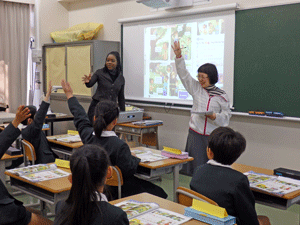Case Studies - Everybody Up
Noda Gakuen Junior and Senior High School, Yamaguchi

Name of the Teacher: Lucas Bohaty
Course name: Junior English
Uses Everybody Up (1st edition) Levels 1-3 for students in grades 3-6. One 50-minute lesson per week, 30 lessons per year.
Overview:
We use our own teaching approach, however use the student book, workbook and picture cards in every lesson. During the lessons we use the pictures or activities from the student book at least once per lesson and supplement this with many of our own games or activities. Because Everybody Up is easy to follow and the units follow a set pattern, we’ve been able to adjust our lessons to include most of the student book's material in our 30 yearly lessons.
Students' Reaction:
The students enjoy the pictures and the language boxes are easy for them to read and understand. Also, the target language is simple and easy to follow, which allows students to proactively participate in class, and helps them build confidence, even in mixed ability classes.
Kamakura Women’s University Attached Elementary School, Kanagawa

Name of the Teacher: Junko Takatsu, Simone Symister
Uses Everybody Up (1st edition) Level 2 for the 2nd and 3rd grades, and Level 3 for the 5th and 6th grades. One lesson per week. One of the goals is to achieve Eiken 5th grade level or similar at the time of graduation.
Overview:
At the beginning of each lesson, students practice greetings and key phrases, take a mini-test or enjoy story telling. Everybody up is used as a main textbook for the rest of the lesson. Each lesson covers an appropriate amount of the textbook, about 1-1.5 pages per lesson, confirming the students’ reaction and learning progress. For the songs, chants and story parts, we adopt gestures and role play style activities. As for the CLIL part, we can smoothly conduct the lesson by simply following the textbook.
Students’ reaction:
The students proactively participate in the lessons with natural unprompted gestures. During the role play in the story section, students enjoy taking turns and trying the role play again and again. Students also go beyond just following the story, they analyze it and try to guess the meanings behind the illustrations. We believe the textbook is helping students to improve their critical thinking skills as well.
Teaching tips:
Mixed-ability level of students is one of the common issues among elementary school English classes, and our classes are no exception. At times when we think it is appropriate, we use Japanese language to explain the meaning of words and phrases so that every single student can follow. Also, when the audio speed is too fast for some of the students, we adjust the playing speed of the audio system, or the ALT who is a native English speaker pronounces clearly in the appropriate speed. This way, we can successfully make all our students engaged in the every lesson.
Editor's note:
Their motto is 'don't turn students off to learning English' and 'make students believe communicating in English is fun'. They are successfully motivating students in a natural setting, and successfully getting their students to participate in classes and enjoy communicating in English.
Magic Time Level 1 is used for the 1st and 2nd grades to build basic English skills. Also, Oxford Reading Tree is used for the story telling section of English lessons.
Share your Everybody Up experience!
Are you using Everybody Up in your classes? If you are interested in sharing your ideas on how to maximize the coursebook, please contact us.
newsletter.japan@oup.com